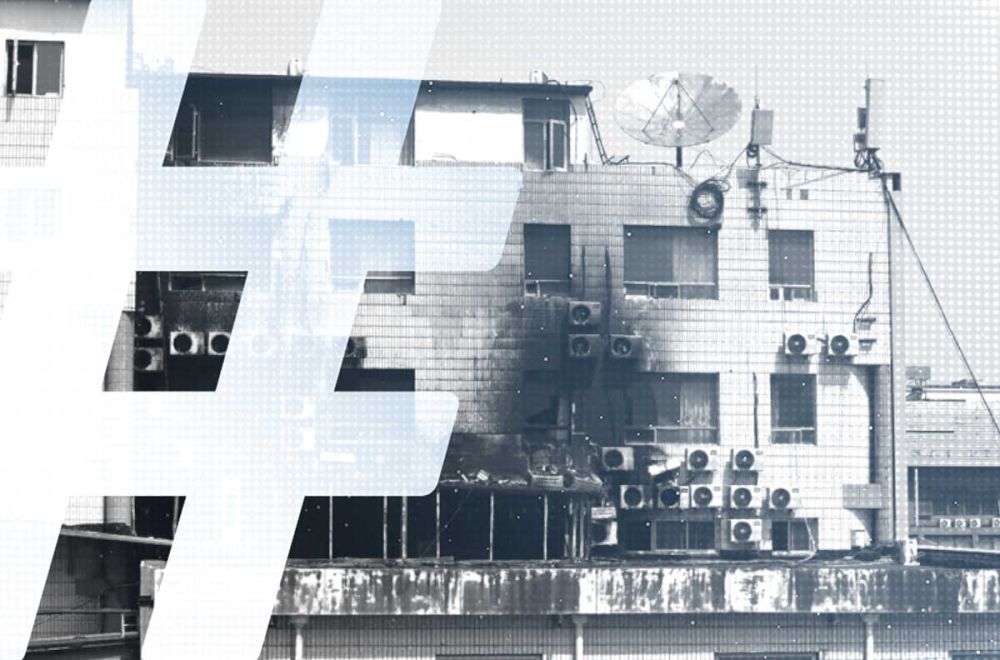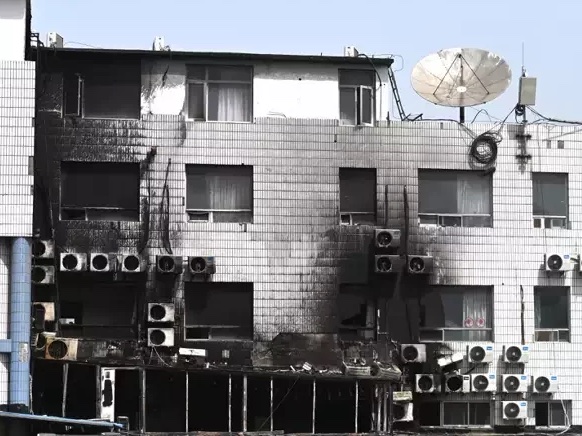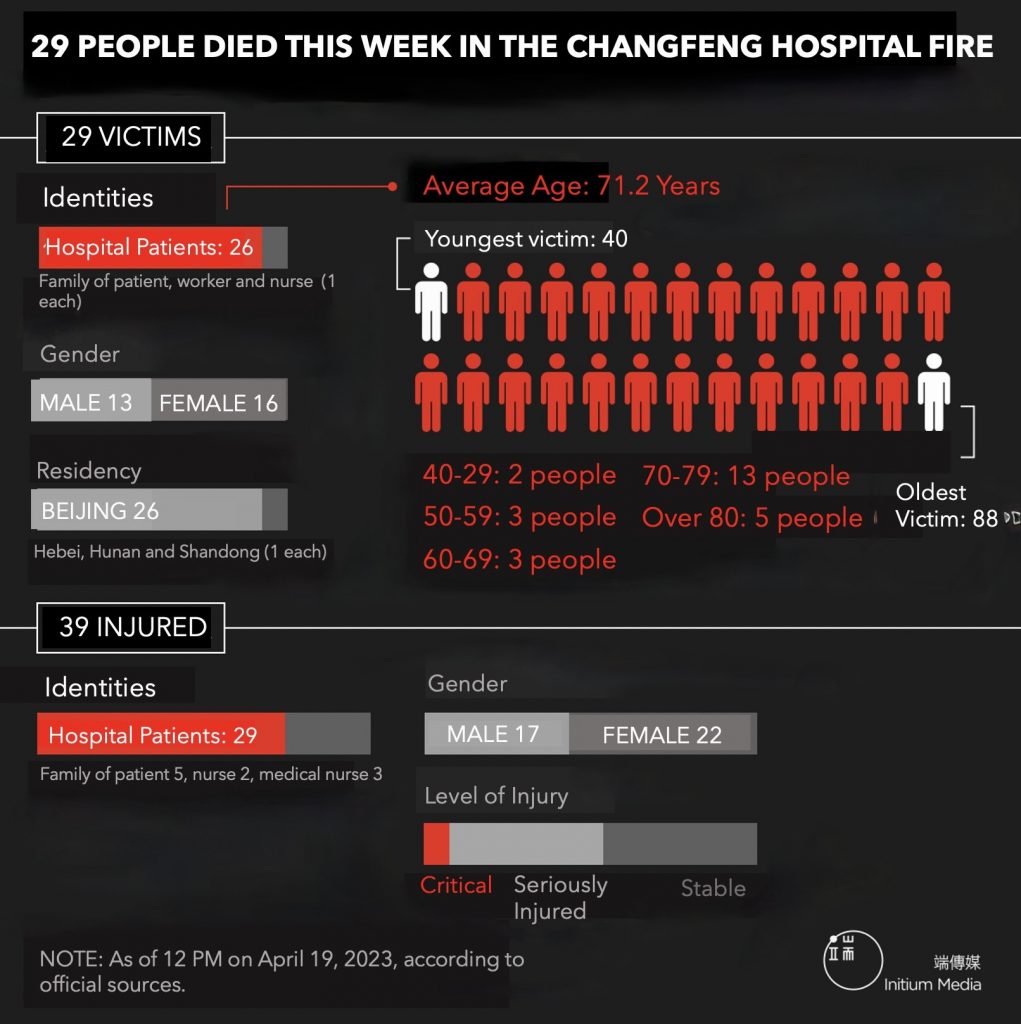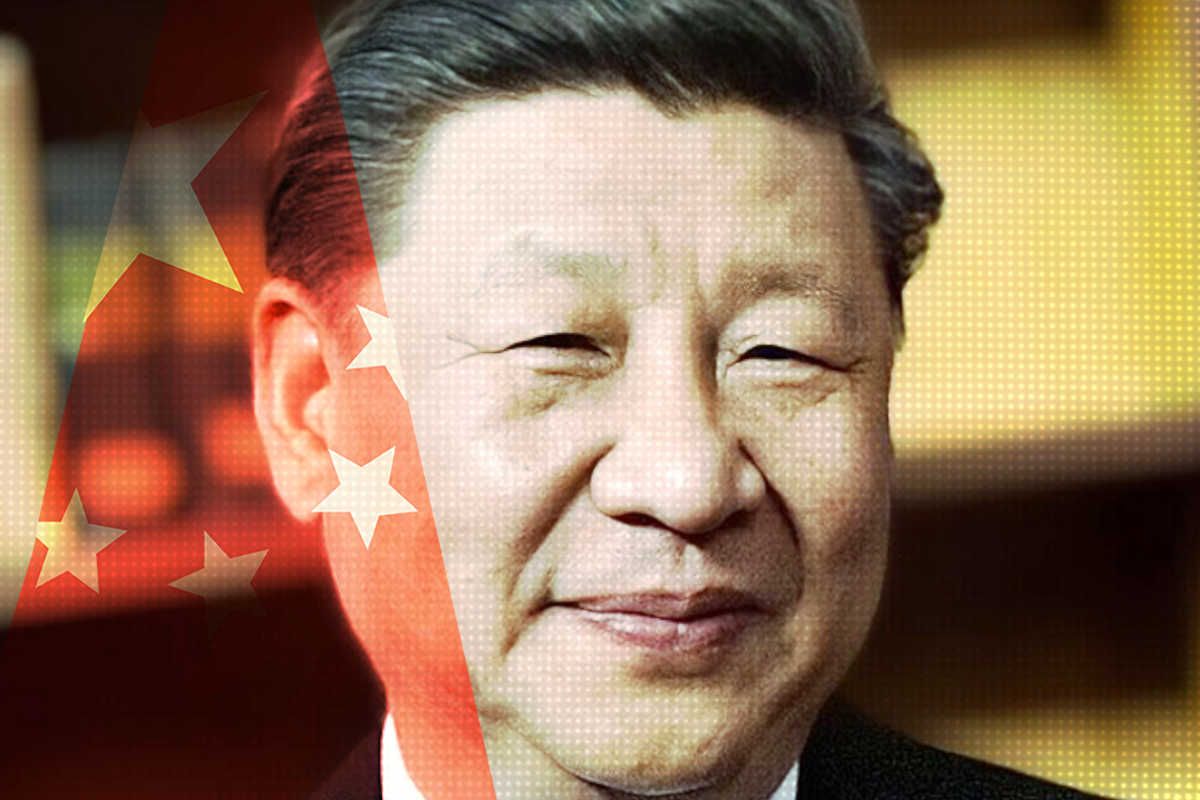
“At all media, there is an unwritten rule that you don’t do negative news in Beijing, and that all [media] leaders must be politically conscious,” says Wu Li (吴黎), a journalist who has worked in the profession for more than five years, focusing mainly on society news.
At around 9 PM on Tuesday this week, an official news bulletin about a fire at Beijing’s Changfeng Hospital (长峰医院) began circulating on social media from the Beijing Daily, the official organ of the city’s leadership, accompanied by the sharing on social media of a video of the fire taken by a local resident. But aside from these posts, it was difficult to track down further information about the fire online.
Seeing the news bulletin, local journalists hurried to the scene and to other hospitals where patients had been transferred. As they set to work, they were also asking a question that puzzled and shocked many city residents: How was it that the fire had broken out at 1 PM that afternoon, eight hours earlier, but there had been a complete news vacuum for that entire time?
In an era when anyone can witness and communicate information, how was it that there had been not a drop of news prior to the official bulletin?
In those first hours of catch-up, the priority was getting the story out, so this question had to wait. Before long, the first images started coming out from Caixin and other mainstream media organizations on the scene.
How was it that the fire had broken out at 1 PM that afternoon, eight hours earlier, but there had been a complete news vacuum for that entire time?
By Wednesday afternoon (April 19), a flood of reporting had emerged from such media outlets as China Youth Daily, Lifeweek, and Caijing. All of these media had worked through the night to tackle the story from different angles — focusing on the families of the victims, the issue of fire prevention at medical facilities, or background reports on the Changfeng Hospital.
On Wednesday afternoon, reporters from a number of media also told Initium there seemed to be no restrictions on reporting for the time being.
But then, late Wednesday night, about 24 hours after the initial news release from Beijing Daily, a journalist informed Initium that restrictions were now in place.
Eyewitnesses Silent
Among the 10 journalists and contacts at social media platforms reached by Initium, no one could explain why there had been an eight-hour delay in reporting the story of the Changfeng Hospital fire. However, there were various guesses based on the information they had available. Some thought it was purely accidental, while others supposed there had been a reporting ban. Others surmised that social media platforms had altered the way restrictions were applied and information censored, effectively stopping the story in its tracks.

Like other journalists reporting this breaking story, Zhang Qing (张晴) arrived on the scene later at night on Tuesday, April 18.
When Zhang asked local residents close to the hospital whether they had known about the fire, the answer each time was “I don’t know, I was at work.” The scene of the fire, said Zhang Qing, was about two or three kilometers away from the nearest subway station at Liuli Bridge, and quite far from the nearest residential area. The fire had started sometime after noon, and people were likely at work or on their lunch breaks. Because the fire was extinguished within 30 minutes, the smoke likely did not last long enough to attract a great deal of attention.
“Another factor is the relatively strong sense of political consciousness among Beijing people,” Zhang Qing explained. “The strict security that comes along with the annual Two Sessions [in March] and the presence of police on the streets doing ID checks and so on cause everyone to internalize this sort of censorship. That might also be why there weren’t so many people filming or posting videos.”
However, Wu Li (吴黎), another journalist who visited the scene, had different information. Wu also learned of the fire from the official Beijing Daily bulletin. Like other colleagues in the media, he was “shocked and ashamed” by the situation. So even though his editors did not greenlight the idea of a story on the fire, he went to the scene to report.
In a video distributed around the same time as the Beijing Daily news release on Tuesday night, people could be seen escaping through the windows of their hospital rooms, some squatting on the air conditioning units mounted on the wall. The video, which also was posted to Twitter, showed a drone hovering outside the hospital and blaring the message: “Stay calm and wait for help!” The video was viewed more than 100,000 times on Chinese social media before it was finally deleted.
A neighborhood resident told Wu Li that a lot of people in his building had taken videos around noon on Tuesday, but these were deleted as soon as they were posted in chatrooms.
Several years ago during the National Day holiday, said Wu Li, a gruesome murder had occurred in a remote village in China and the local government had used a truck with an internet signal jammer to block all communication while they deleted the photos and videos taken by villagers. This time, a deadly fire had occurred in the capital city of Beijing, and there hadn’t been a shred of information. Perhaps this signaled the growing sophistication of the means of controlling information. “In the past, at least you could see fragments of information,” said Wu.
Seams Tightening at Social Platforms
One writer commenting through WeChat used the phrase “terrifying silence” to describe the sense of quiet on social media surrounding the Changfeng Hospital fire. Many people wondered whether the content review system on social platforms might have been silently upgraded. Andy, an employee at a video platform in China, told Initium that all content on his platform is first filtered through an automated censorship system (机器审查).
“A number of sensitive keywords will first be preset and there is also image recognition, for example for certain bloody or violent images, fires, and so on. If the machine detects these, it will not release the video or will push it on for manual review.” This step, said Andy, is what they refer to as the “bottom-line review,” which is used to determine whether something is vulgar or has to do with political or security matters.
The review process is both strict and meticulous, Andy said. He cited the example of a previously reviewed short video in which one frame, if you zoomed in several degrees, included a book on a bookshelf with a sensitive title. This sort of video, too, is routinely screened and rejected.
“In the past, at least you could see fragments of information.”
Wu Li, a local Beijing journalist.
Taking news scene material as an example, Andy explained that if someone on the manual review side noticed someone had posted a video of a fire, they would mark this to see whether there were similar videos in the backend. If videos of this kind seemed to be concentrated, a submission would be made to a higher level of review. The platform was extremely sensitive to news scene videos of this kind posted by users, he said, and would tend to be “conservative — very conservative.”
“The basic principle is to deal as little as possible with news,” Andy said. “Even if a video passes the censorship process, it will be subjected to a new round of censorship if it attracts significant traffic. “The hotter the video, the more stringent the censorship standards become.”
Regulators, he added, had previously penalized his platform for certain news events, resulting in substantial commercial losses. As a result, the platform was not eager to become the source of breaking news. Therefore, there was sure also to be direct communication between the platform’s internal censorship department and the Cyberspace Administration of China.
If a story has already become a major news topic, then the platform’s censorship process becomes relatively simple by comparison, he explained. In such cases, it is simply a matter of setting certain keyword restrictions and parameters for key images, so that when users search for information, they can see only content released by government departments and state-run media outlets — and cannot see videos from the scene posted by ordinary users.
“I’m certain that at the time people did take a video of the fire [at Changfeng Hospital] but there was no way for anyone to come across them,” said Andy. He added that when some major society news breaks, another tactic used by the platform is to instead direct traffic to entertainment news posted by marketing accounts, which serves to distract attention away from sensitive news.
Andy’s account is corroborated by the response to the Changfeng Hospital fire on social media platforms in China.
The earliest information that can be found on Weibo was posted at 5:54 PM on Tuesday (April 18), when netizen @SKYsky93258 posted that “Changfeng Hospital is on fire” and included images of fire trucks, police cars, and ambulances lining the road. To date, the post has been reposted by just one person and has received 0 comments.

At around 6:30 PM, a video of the fire was finally posted to social media but was quickly deleted. Some local media such as BTime (@北京时间) and other local Beijing media re-posted the story, but their videos were later removed. One of these local media, Beijing Dafengfeng (北京大峰峰), is currently under suspension and prohibited from posting content, its last posts dating to April 19. The earliest thread on the fire on Weibo, “Beijing Changfeng Hospital catches fire, people escape to outside air conditioning units,” is no longer available.
The topic “29 Killed in Beijing Changfeng Hospital fire” finally trended its way to Weibo’s Hot Search list at around 12:33 PM on Wednesday, just after the Beijing government press conference. Information about the fire inundated social media such as Weibo, Douyin, and Kuaishou, but this was mostly repetitive information from official sources and it was difficult to find video from the time of the incident.
Silence Reigns Before the Ban
“In nearly all breaking incidents in the past, the government was mostly on the back foot,” Wu Li said. “It was only after the story broke through other media or through social media accounts that they passively responded and released official bulletins.”
He recalls that when he started working as a journalist his older colleagues would tell him how, 10 years earlier, it was only after reports came out that the authorities would step in and apply censorship. But this time, Wu Li was able to pitch the story to editors only after seeing the official bulletin — and still the story idea was vetoed.
Wu Li also remembers that when a fire broke out in a housing block in Beijing’s Daxing District in November 2017, a ban came down shortly afterward. But commercial media and social media accounts were able nonetheless to make a commotion before things finally quieted down. “The technology of official censorship has improved, and bans can now be applied much sooner,” he said. “This has resulted in an oddly distorted phenomenon: the authorities can block all information at the source, and only later release an authoritative official bulletin.”
In fact, in the general process of news reporting, social media is just one of a number of sources from which journalists can learn about breaking news. Human sources at hospitals and other facilities have often been the first sources of news stories and other information. But as more experienced journalists have left the profession, and as sources with the system become fearful of speaking up and “having an impact on public opinion,” these human sources have been cut off. Media with message boards and hotlines for information are also adhering tightly to “official information only” (只转官方消息) policies, which means that news increasingly relies on the official social media accounts of the government, the fire services, and the police.
And so the process has now become one in which those media with a sense of responsibility for reporting the news can only wait for disaster stories to reach the top and then be reported through official bulletins, after which they can seize on a brief window of time to produce their own content.
According to one source, the fire was reported to the fire services at noon on Wednesday, April 18. The owner of a nearby store posted about the fire in a WeChat group later that afternoon, and was puzzled that he hadn’t seen any press coverage. Finally, the news reported in the media was sourced from the official bulletin from Beijing Daily. Why had it taken so long? Perhaps it was an internal effort to tally casualty figures and rate the incident. In any case, the exact circumstances remain unconfirmed.
In addition, the haze caused by this ban may have prevented journalists from breaking through in time.
“Over the past two years there’s been the vague sense of a ban,” said Zhang Yan, a reporter for a local newspaper in a southern province. This has subliminally influenced how media react to breaking news. “The eight-hour vacuum may not necessarily be related to the ban but everyone has the ban in their minds,” says Zhang. “Can they cover Beijing news? Are they allowed to go to the scene?”
It was an hour after seeing the official bulletin and noticing public sentiment percolate that Zhang asked the editorial department if they wanted him to follow up on the story.
At first, there was no response. Only the following morning did they finally relent, noting that they hadn’t yet received an outright ban on the story. A few hours later, Zhang was advised to “pay attention to the extent” (注意尺度) — [meaning to remain within the bounds and not broach sensitive issues] — as well as the direction of reporting. He was told, for example, that he could speak with eyewitnesses, survivors, and victims’ families but was not permitted to speculate on the cause of the blaze nor to focus on why it took eight hours for an official notice to be issued. Zhang wanted to go report from the scene but his superiors shot this down, worried he may attract the attention of authorities.
Zhang says that a journalist friend in Beijing experienced similar difficulties. He missed the chance to report live on the story because he was worried about a ban and assumed the site would be cordoned off. He woke up the next morning filled with regret.
At the same time, it is clear that the threat of bans and censorship lingers at many moments in the development of the story when information breakthroughs might be possible. Some interviewees told Zhang their phones had been confiscated as soon as they escaped from the burning building. Others left their phones behind in the panic. Zhang suggests this may have been one of the reasons for the eight-hour delay. In the final draft of his news story, the detail about phones being confiscated was erased. So, too, was any mention of how people had been forced to jump from windows to escape.
Within the media, the means of censorship are legion — including the designation of “sensitive word” lists. Certain events or people are deemed untouchable if they include keywords associated with reporting bans. These bans can persist for as little as a month, or as long as several years.
“In a city of 20 million people, it’s miraculous that everyone had to wait until that night to learn about the fire from an official release,” said Lüqiu Luwei, a media scholar at Hong Kong Baptist University. “This kind of strategy must have developed and matured during the pandemic.”

Epilogue
In the aftermath of the fire, victims and other injured parties at Changfeng were moved to other nearby hospitals, and officials said at a briefing on Wednesday that they had deployed staff to set up a special team for the 29 victims. This tactic was used in the past to deal with the families of mine disaster victims in China, and it has been used by officials around the world to deal with major emergencies. After the China Eastern Airlines crash in March 2022, a similar special team was set up to deal with victims’ families.
Zhang Yan said that the interviewees at Changfeng Hospital seemed more cautious than usual this time, and demanded three separate times to check his journalist credentials. “When checking into people before, they were never so nervous,” he said.
Outside the intensive care unit at one of the transfer hospitals, Wu Li saw staff following victims’ relatives with flowers in their hands. One family member whispered to Wu: “Our relatives are dying and they’re holding flowers to preserve stability. It’s shameless. There were other family members who didn’t want the flowers and threw them away, then the staff picked them up again and gave them to this family.”
This article originally appeared in Chinese at Initium Media. The names of all interviewees have been changed as per their request.





















